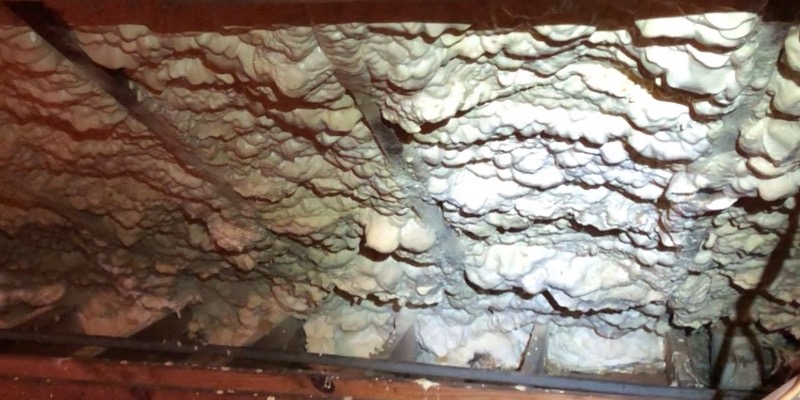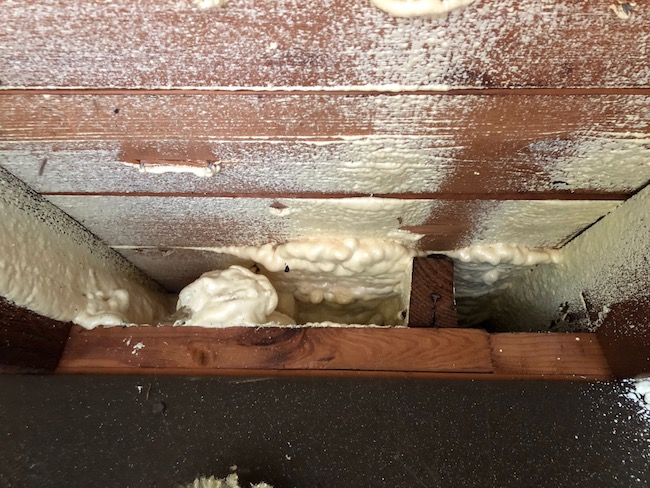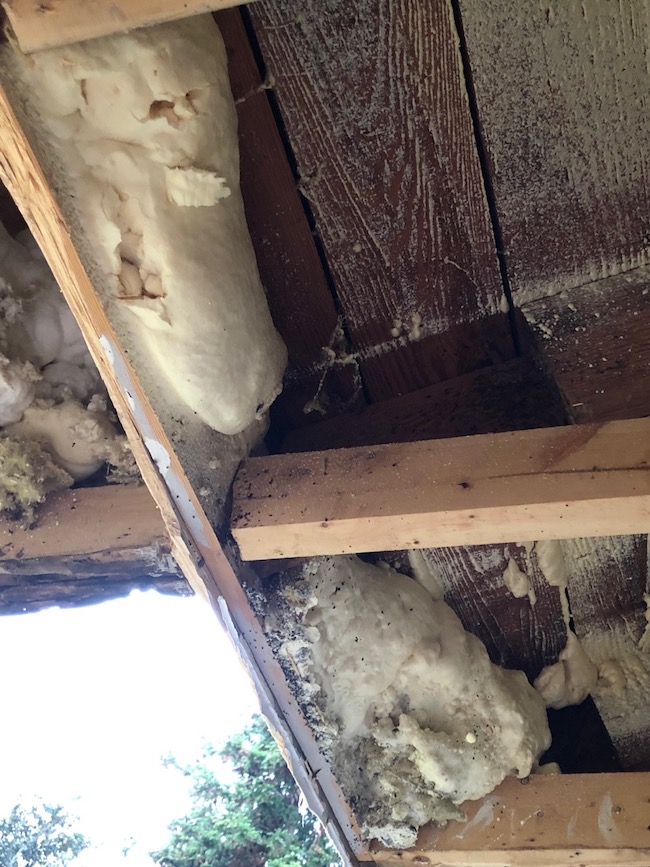Spray Foam Insulation at the Edge – A Forensic Analysis

An attic that’s brought inside the building enclosure is a beautiful thing. This is most often done with spray polyurethane foam (SPF) insulation, either open-cell or closed-cell. Here in the southeastern US, open-cell is most often the spray foam of choice. But how well does this process of encapsulating the attic actually work? Well, as any good building scientist will tell you, that depends.
In my case, I just bought a house that had spray foam installed in the attic in 2012. I’ve discovered many problems with what the contractor did and I’ll have more about that in future articles and videos. Today, though, I want to focus on just one aspect of spraying foam in an attic: what happens when the installer sprays the foam into the eaves.
Shooting the eaves
In the lead photo above, the foam appears to be filling the eaves pretty well. But that’s the attic view. What would it look like if you could see it from the outside? Well, I’ve had that opportunity this week because we’re having all the soffits, fascias, and gutters replaced. After the crew removed the old boards, I got in there to take a look.
This one looks good:

The spray foam made it out to the edge of the cavity, covering the top plate and providing what looks like a pretty good seal.
But not all of the cavities look so good. Here’s another one:

This one is really interesting. You can see the spray foam back in the cavity. You can also see that some of it shot out past the cavity because there’s some on the roof deck in the soffit area, along with a spray foam shadow on the roof deck where that ceiling joist in the cavity blocked the spray foam.
It’s possible that the foam did make a good air barrier in that location, preventing air from moving between the soffit and the encapsulated attic. But even if that’s true, there’s still a deficiency here: There’s little insulation over the top plate of the exterior wall. It’s bad enough that the low-slope roof means that we can’t get enough insulation over that exterior wall, but when spray foam doesn’t cover that area much at all, we have extra heat loss in winter and heat gain in summer in that area.
Another interesting aspect of what happens when the installer sprays the foam at the eaves is the overshoot. In the photo above, you can see it on the roof deck over the soffit. The photo below shows that it doesn’t stop there. It shoots all the way across the soffit and hits the back side of the fascia.

How to get the edges insulated and sealed
To prevent this problem, the spray foam installer needs to do a little extra prep work. To keep the spray foam from shooting all the way across the soffit and leaving the cavity above the exterior wall empty, there needs to be some kind of material to stop it. This could be a piece of fiberglass batt or cardboard or foam board. There’s just got to be something to stop the foam and keep it where it’s supposed to be.
In existing homes, doing this can be difficult with a low-slope roof, but that doesn’t make it less important. If the house is undergoing additional work and the soffits happen to be open, that extra prep work can be done from the outside. In new homes, it’s a matter of planning for this as you go. Install the baffles or whatever blocking you’re going to use during the framing.
I like spray foam insulation; we got more installed in our attic last month, and now it’s much better than it was. (More about that coming soon!) Now that we’re having the soffits and fascias replaced, I’ve been able to address the problem with the eaves I described above…and that’s the subject of my next article.
Related Articles
Seizing an Air-Sealing and Insulating Opportunity (the followup to this article)
My New Project: A 1961 House With Home-Performance Angst
Humidity in a Spray Foam Attic
3 Reasons to Remove Attic Floor Insulation in a Spray Foam Attic
4 Pitfalls of Spray Foam Insulation
NOTE: Comments are moderated. Your comment will not appear below until approved.
This Post Has 25 Comments
Comments are closed.

I am about to engage a spray
I am about to engage a spray foam applicator in Glasgow, Scotland. I will take a few of these points on board. The spray industry is certainly gaining some ground in the UK. I like it due to the inflexibility of installing traditional rigid PIR boards and the attitude of some of the installers (trained or not).
Scott, good luck with your
Scott, good luck with your upcoming spray foam installation. Here are a couple of other articles that might help you:
4 Pitfalls of Spray Foam Insulation
2 Ways to Get the Best Insulation
PS I always have to look up PIR (polyisocyanurate foam board) when someone from across the pond uses that abbreviation. But I still don’t know where the “R” comes from.
Actually, “PIR” commonly
Actually, “PIR” commonly stands for polyisocyanurate – not polyisocyanate – that is an entirely different product. Then that would explain where the “R” comes from.
Thanks for the correction,
Thanks for the correction, Charles. I was thinking polyioscyanurate but wrote it with two letters missing. I’ve corrected it now.
You are supposed to have air
You are supposed to have air coming in through soffit
Donald, yes, that’s true for
Donald, yes, that’s true for vented attics and vented cathedral ceilings, but when you encapsulated an attic with spray foam insulation or install rigid insulation on top of the roof deck, you don’t want the attic vented with soffit vents, gable vents, ridge vents, or anything else. It’s a conditioned attic.
Before you started any work
Before you started any work did you do a blower door test on the house? Before and after numbers would be interesting.
Dave, yes, of course I’ve
Dave, yes, of course I’ve done blower door tests on the house. I’ll be writing that up at some point, too, but briefly, I got ~6,700 cfm50 (11 ACH50) before adding more SPF to the attic and 5,200 cfm50 (8.8 ACH50) afterward. We also did some zonal pressure diagnostics and that improved greatly after the additional foam went in.
Recently had blower door test
Recently had blower door test on recently purchased 1989 house. 2150 cfm at 50 pascals. Should I include volume of unfinished basement in ACH calculations? The basement holds HVAC but doesn’t make serious attempt to condition for comfort, 2 registers and minimal fiberglass blanket insulation.
Another really common problem
Another really common problem we see is the contractor spraying down to the top of the existing ceiling insulation & stopping there. Amazing but true, we even had one contractor tell us, “We don’t always spray to seal, sometimes just to insulate.” We don’t work with them anymore.
Also we have had situations where the sprayer sprayed to the roof deck over the opening and let the open cell foam expand to fill the gap. It looks like a complete spray but the problem with that is that it doesn’t always provide a good seal. In most climates this might go unnoticed but for us it can cause mold in the attic in some cases. The foam really needs to be sprayed from the roof deck, continuously, down to the top plate so if fully adheres to the surfaces and provides a continuous seal.
Good points, Skye. I guess I
Good points, Skye. I guess I shouldn’t be surprised to hear that a contractor told you they don’t “spray to seal, sometimes just to insulate,” but that’s just horrible. Anyone in the spray foam business with that attitude needs to find a new line of work. Spray foam in an attic, as you say, needs to make a continuous air barrier from the roof deck to the top plate.
I have a question/take
I have a question/take exception regarding your statement “The foam really needs to be sprayed from the roof deck, continuously, down to the top plate so if fully adheres to the surfaces and provides a continuous seal.” Everything I have read states that insulation should NOT contact the roof deck so that air coming from the soffit vents can dry the underside of the roof deck, and you certainly do not want to seal the opening between the roof deck and the top plate or there would be no air flow. I understand you are insulating the top of the attic space at the roof, so it seems to me you need continuous baffles (like the common foam type) from the soffits to the attic ridge line to allow the underside of the roof deck to breath. Or are you not concerned about the roof deck breathing?
John, good question. No, an
John, good question. No, an encapsulated attic does not need to have the roof deck vented. The roof deck — and every other part of the house, too — has no need to breathe. First of all, that’s a confusing term to use for buildings because it’s used in different ways. Some people use it to refer to air movement; some use it for moisture. And it’s possible you may be referring to the movement of heat to keep the roof cooler. So, no, an encapsulated attic doesn’t need a vented roof deck. It’s certainly possible to put one in, but roofs with spray foam insulation on the roof deck work fine without such venting.
Do you have any feedback on
Do you have any feedback on the value of spray foaming as an alternative to crawlspace encapsulation? I have a 1920s vintage house in ATL with open dirt crawl and am debating the best solution…any past articles on suggestions? Thank you.
Mitch, spray isn’t an
Mitch, spray isn’t an alternative to crawl space encapsulation; it can be a part of crawl space encapsulation. One of the best and easiest ways to insulate the foundation walls is with closed-cell spray foam. I’ve written a lot of articles here in this blog about that topic and you can use the search tool to find them. I’ve also got a series on crawl space encapsulation in the Knowledge section linked at the very top of each page.
We use our blower door rig
We use our blower door rig NOT just to get an x.yACH50 figure but also to QC sprayfoam. We provide an allowance for that on all new construction and deep retrofits…we pretty much insist on it as an HVAC company because success of an HVAC system depends on it conditioning just the home, NOT the surrounding neighborhood.
Our agile duct guys are well suited to pursue leaks at the all-important eaves. We wind the blower door up as high as it’ll go, sometimes adding a second fan. Above 100 or so Pascals, leaks start to audible hiss / whistle.
We employ 3 separate embarrassingly bright neon spray point colors to circle foam misses. The three colors are used since testing is often iterative: test-mark-correct; retest-mark-correct. The neon pink spray paint is held in reserve for jobs requiring a third iteration.
If all else fails, reverse the fans and fire up the smoke machine…hold 3-5 Pascals while smoking the attic (helps hold the smoke up in the attic. Then we goose the fans and surround the home.
Curt, including that air
Curt, including that air leakage testing is something all HVAC contractors should do. An overall air leakage rate for the whole house doesn’t tell you how well sealed an encapsulated attic is, and if you’re putting ducts up there, you need it to be tight.
I didn’t know about using sound to find leaks by cranking up the pressure. That’s a really cool tip!
Before you smoke the attic, do you alert the local fire department and the neighbors? I’ve heard of fire trucks showing up during tests like this because neighbors see smoke and call it in.
We spray foam under roof deck
We spray foam under roof deck on every and routinely get ACH50 numbers of .5 or less. But then, we use precast insulated concrete wall panels so we are basically building a boat. One point I would like to make: We only use closed cell foam as we derive the structural benefits of “gluing” the roof deck to the trusses. Open cell does not do this. Also, if we use 2×4″ truss top cords, when they spray, the foam covers over the top cords and creates a thermal break. Good stuff.
We have had on incident where
We have had on incident where community security showed up owing to smoke alarms from smoke testing…no fire trucks so far.
Closed cell is my personal go-to for the reasons Thomas cites above. Open Cell has been cited by Lstiburek as causing some sheathing moisture fails.
Another great article with
Another great article with some real world info. It’s also great to hear more people are starting to do blower door guided quality checks on foam, based on the comments.
My only advice is to never use fiberglass, or any air permeable material for blocking with spray foam. Of all the installs I’ve gone behind when fiberglass is used as blocking, retrofit or new construction, Ive yet to find one that was successful at creating the air seal needed at the top plate, even if the blocking was foam from exterior and interior sides. Most people are putting fiberglass directly on top of the too plate leaving no, or very little space for the foam to seal to the top plate. Even worse on new construction because then when they come by and shave excess foam, you end up with visible Fiberglass blocking, or a depth of foam that does not create an air barrier, leaving false seals throughout.
Don’t be lazy folks! Spray to seal.
I used rockwool for block the
I used rockwool for block the eaves on my own house. 10/12 pitch roof and I placed the rockwool so you could see 4″ of the 2×6 top plate. Do you see any issues with this approach if executed as described?
The attic has a full unfinished floor with floor sheathing out to the band joist, so I cut the floor sheathing back about 16″ all the entire way around. SPF was applied over down the roof and onto the top plate. Then they sprayed from the ceiling bellow, up to the underside of the floor sheathing/top plate to seal the band joist. There were some missed spots getting up to the top of band joist because it is difficult to get the gun pointed up there. A 20-24″ opening would have been better.
I realized later with an IR camera and box fans that I should have done a quick spray over the front of the top plate and bottoms of the rafters at the top plate.
Looking at installing spray
Looking at installing spray foam to insulate / block air infiltration onto the roof sheathing in an attic in Colorado, so we can install HVAC equipment in the attic space. Should there be a concern in areas prone to forest fires with using spray foam which has an auto-ignition temperature below 700F (way below the heat of a fire)? Is there an effective way of installing less combustible products, like dense-packed cellulose?
I am up against a building
I am up against a building height restriction so energy truss height will be limited. I plan to use open cell spray foam to encapsulate the attic (low desert climate). Can closed cell foam be used above the plates since it has more R-value per inch, then switch to using open cell foam for the rest of the attic or will this cause some type of incompatibility in the attic (moisture or whatever)?
Allison – We just bought a
Allison – We just bought a house built in 1919: slate roof, uninsulated walls, dirt crawlspace. Stucco siding and plaster walls. We’re pulling out the plaster walls to run new wiring and plumbing, so will be adding insulation. Guessing I won’t be able to afford spray foam for 100% perimeter, I was going to encapsulate the crawlspace with rigid foam board, air seal with spray foam, heavy liner. For the walls, thinking rockwool, and spray foam the underside of the roof to bring the attic into conditioned space. This post is super helpful regarding the eaves – so thanks for that! But I’m concerned about the 100 year slate roof and about applying spray foam directly to it. Closed or open? Ridid instead, and then air seal? We want to be in a spot where we can finish the attic, so the depth is definitely a consideration regarding ceiling height post drywall add. Thanks in advance!
The off gassing of spray foam
The off gassing of spray foam can be very toxic and many have had to move out of their homes after using it so it is not for everybody.
And those that decide to foam their attic soon find they have moisture problems they never had before.
AIR is in fact the best and cheapest insulation which is why ventilated attics were invented.
And as always sealing a home airtight may save you a few pennies per day on your energy costs but at what cost to your health